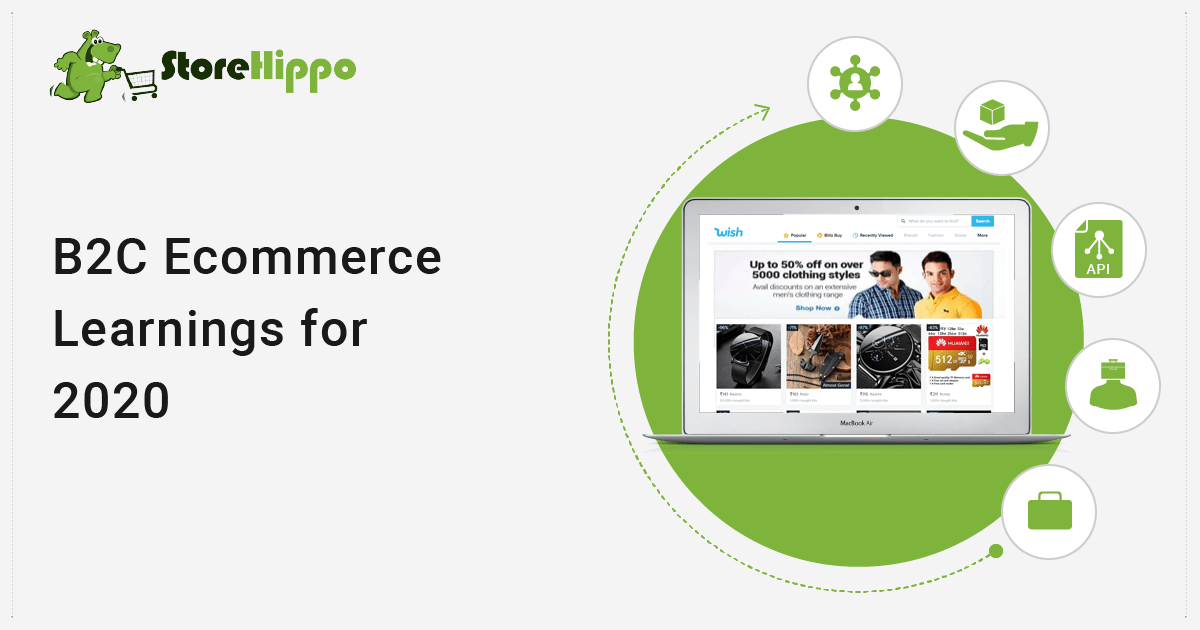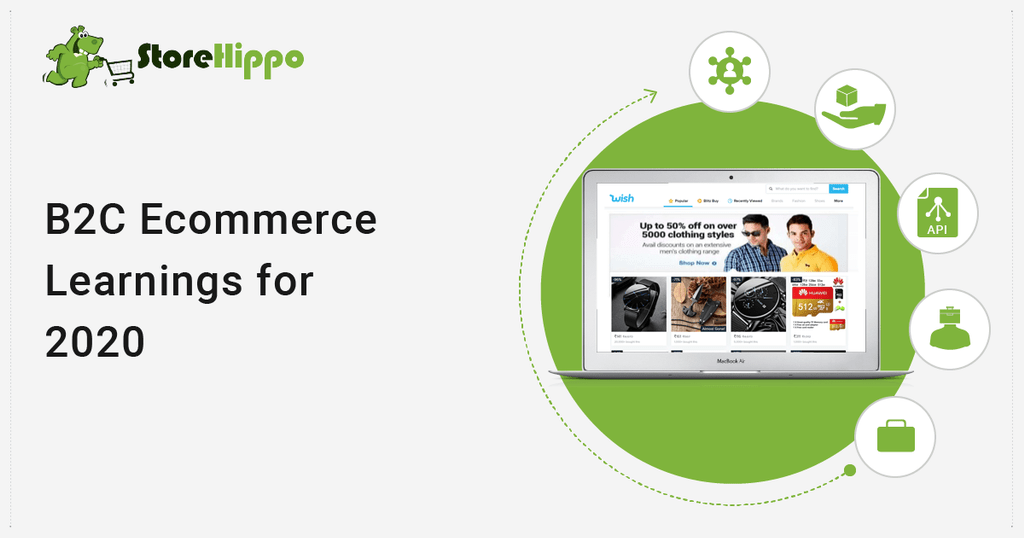It is interesting to look back at the evolution of e-commerce, growth of online sales, innovative trends in 2019 and think forward to capitalize on the opportunities in 2020 and beyond. Every year, the global e-commerce market is growing steadily and it has already crossed the US$ 2 trillion (Source: eMarketer). This growth has been fueled by the easy access to e-commerce, growing purchasing power, penetration of internet, and mobile shopping.
Global online business has been on a spiked growth trajectory. And the growth of e-commerce is expected to grow by 1,200 percent from 2018 to 2025, indicating the enormous growth of online businesses. The statistics summary of top 10 countries also shows that India has the highest change percentage, while China has already surpassed the UK and US markets.
Most of the online business owners will agree that you need to adapt to the new trends and to stay strong in the competition. Monitoring the trends in the online industry is not a choice or a hobby, but it is a necessity to drive your online business forward.
Table of Contents
As we are moving into 2020, here are 10 B2C e-commerce learnings from 2019 to keep tabs on.
1. Adoption of Fast & Moving Fashion
Fast fashion accounted for 66% of online fashion in the first half of 2019 and is surely going to explode in 2020. To succeed amid the dynamic fashion trends, e-commerce companies need to build new capabilities. The fast-moving fashion requires you to jump on the trends and give a new freshness level to the products for consumers. Are you also targeting to drive recurring purchases through repeat customers and make your business more stable? Well, you need to think about agility and speed, think about how you can optimize existing resources without compromising quality and experience.
Look out for an online solution provider that offers the much-required agility to your e-commerce business by offering advanced technology, seamless connectivity, and an awesome buying experience to your customers. This is one of the most necessary steps to grow customer lifetime value, have a positive return on investment, expand your business and differentiate your shopping game from competition.
2. Product Visualization
Visuals play a major role in the future of e-commerce with the emerging features of Artificial intelligence, Augmented reality. It has a huge potential to fuel the movement of large amounts of data and visual information. 2019 has taught us to explore the features of conversational marketing, chatbots, and other tools that are changing the consumer experiences for better. This trend will continue in 2020 and beyond as it removes the heap of friction from the overall journey of customers. The technology and AI-powered solutions help discover behavioural patterns of consumers and ultimately engage a maximum number of customers.
If you have not already invested in a marketing building technology, it is a good time to include live chat and more functionalities to boost your B2C conversions.
3. Rolling of subscription services
As we are heading into 2020, the prevalence of subscription-based services is also heading to new ways and it makes sense for both consumers and online businesses. Let’s understand why it makes sense.
On the customer side, subscription-based services provide an expected experience to consumers and ensures regular delivery. The value received in the subscription model is much higher in context to personalization, monetary savings, and convenience. You can also tailor the products for individual customers, based on the information about the customer, which fulfils the personalized shopping experience. On the e-commerce companies’ side, they get regular orders of a certain value that provides sustainable business revenues. Hit the subscription bandwagon with state-of-the-art technology, strong replenishment services by choosing one of the best enterprise solution.
4. Solidification of Physical and Digital
While the brick-and-mortar retail market is declining but at the same time, many companies are also reinventing their customer experience by solidifying physical and digital stores. The key reason for solidification of offline and online B2C businesses is that today’s consumers need not visit the brick-and-mortar location to make a purchase, but they look for a much better experience when they visit the store.
Having a physical store allows your businesses to provide Omni-channel experience such as pick up from the store, store-specific promotions, and also reduces shipping costs. Also, physical stores are a great way of connecting better with customers while gain valuable insights and feedback from the customers.
5. Headless e-commerce
Keeping an eye on e-commerce growth and dynamics, get your online business headless and future-proof your brand. The key reasons for using a headless platform allows you to enhance customer experience, add multiple presentation layers of choice, edit the content with ease, and a seamless Omni-channel experience.
The best memorable customer experience of consumers is vital and to accomplish this, most of the online business owners will rely on headless commerce using one-stop enterprise commerce platforms.
6. More Shipping options
Some of the major e-commerce problems are related to shipping like delayed shipping, fewer options for delivery, high shipping costs. These are some of the reasons that led to an increased number of abandoned carts. The shipping related concerns are the most common excuses revolving around abandonment of shopping carts.
Looking at the bigger picture, the expansion of shipping options is necessary to survive in the marketplace. Well, having brick-and-mortar store locations is the simplest solution as the customers can pick up their orders at the nearest location. But if you do not have the option of a physical store, try integrating a seamless shipping solution to mitigate the maximum logistics issues of customers.
7. Retention-first technique
The dynamic business growth in the e-commerce industry requires consistent efforts and retention being one of the most trending things in 2020. It is the top growth strategy for companies to excel in business and at the same time, the popularity of subscription models is also boosting customer retention strategies.
It is important for online businesses to keep the customers engaged to drive growth. Look for a solution that allows you to have all your marketing consolidated in a single platform. It will lead to automation of business processes and marketing techniques like discounts, personalization, dynamic forms, abandoned cart solution, email and notification support, live chat, and much more.
8. Multi-channel Selling
Multi-channel selling is not a new twist in the e-commerce industry because before the advent of e-commerce channels, the businesses were incumbent on the company catalogs and physical stores to reach new customers. As soon as the e-commerce industry blossomed, it has opened another channel for businesses, but the main difference is that now you can sell globally.
So, the point is that the number of channels will not stop evolving, you have to keep up with the pace of development. And a multi-store B2C website can do this job very well. You can start your chain of online stores to manage multiple storefronts, and still have centralized customer information and inventory details. It helps you generate higher returns on investment with targeted marketing techniques.
9. Real-time customer interactions
How much time do you take to respond to a customer query? Is it more than 10 minutes? Well, there are more possibilities of losing a customer when they don’t get a right and timely response to their queries. Today, most of the consumers expect real-time interactions with the companies. To fulfill this expectation, you need to have staffing as well as technical capabilities to engage with the customers and provide timely responses to them.
10. PWA for e-commerce
With the increased rate of mobile shopping, a progressive web app has become a necessity to sell online. Every popular website is using PWA technology to achieve great success in the online industry. PWA is simply a mobile application that ensures the optimal usability of your e-commerce website and allows customers to explore and shop on mobile.
This allows customers to have a streamlined and comfortable shopping experience as they can use the website without downloading the mobile application. Things like functionality, navigation, ease of use, website experience are going to stay in 2020 and beyond.
Investing in PWA is not an additional feature but an essential part of customer experience in 2020.
Key Takeaway
Not every trend is affordable for every business or industry, but it surely teaches us where the industry is heading and helps us to set business goals in 2020. The hack is to pick the mainstream e-commerce trends that suit your market and translate them to your niche. Leverage the maximum of these trends and drive better business growth with StoreHippo. Schedule a FREE 14-day Free Trial today.























Leave A Comment